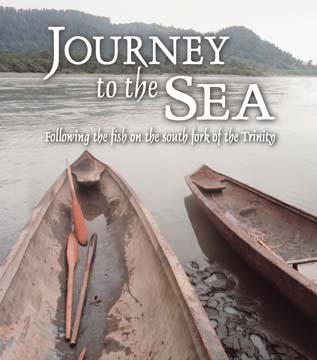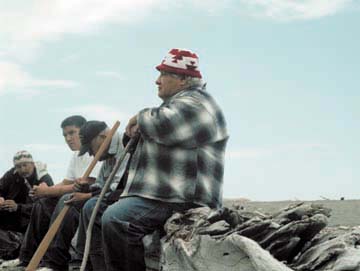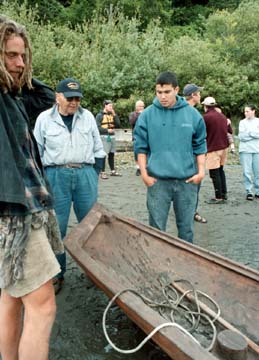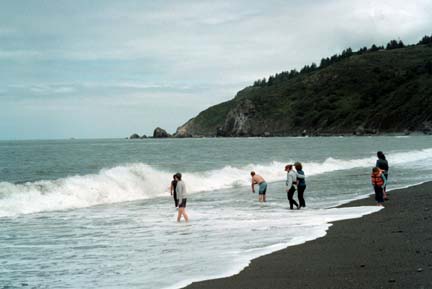|
 
June 16, 2005
IN
THE NEWS | PUBLISHER | ART BEAT | STAGE
DOOR
PREVIEW | THE HUM | CALENDAR

On the cover: photo caption/credit
Journey to the sea:
Following the fish on the south fork of the Trinity
story & photos by LAUREL PEÑA
DAVID SHE'OM ROSE is a man shaped
by the landscape. For 25 years he has lived on the south fork
of the Trinity River, near its remote headwaters in the Yolla
Bolly mountains, raising a dynasty of six daughters with his
wife Paula on homegrown fruit and home-baked bread. His wiry
muscles have been shaped by steep mountain trails and the hard
work of daily life. He wears buckskin clothing tanned from local
deer. His own skin is tanned by years of summer sun.
![[David Rose standing in grass in front of river]](cover0616-Rose.jpg) Rose [photo
at left] came to the South Fork
in 1980 as a self-described "young raving idealist."
He remembers the warm welcome extended by the two families already
living at the community known as Riverspirit. It was early spring
and the families had seen few visitors all winter. They boated
across the rain-swollen river to pick up the young idealist and
bring him home. Rose [photo
at left] came to the South Fork
in 1980 as a self-described "young raving idealist."
He remembers the warm welcome extended by the two families already
living at the community known as Riverspirit. It was early spring
and the families had seen few visitors all winter. They boated
across the rain-swollen river to pick up the young idealist and
bring him home.
"I grew up in Los Angeles
and always had a feeling that I was strange," he explains.
"I only really felt good when my family would go to our
cabin in the mountains around L.A., or the desert, or the ocean.
When I was 14, I realized that I was not strange. I was living
in a strange world, and I could leave."
Through the years of building
homes, taking care of livestock, home-schooling children and
other tasks, Rose maintained his ideals of living "in harmony
with my brothers and sisters and the earth." In 1997, he
founded the South Fork Trinity River Land Conservancy "to
show people the beauty of wild places and to give them the tools
to work to protect it."
But like the landscape itself,
Rose is acquainted with loss. He deeply feels the absence of
healthy salmon runs in the upper Trinity River. After years of
living on the South Fork, he says, "I realized we can't
be sustainable without the salmon. That's a crucial link."
Only native salmon return to the South Fork to spawn; the tributary
has no dams and therefore no hatcheries. Runs have been diminishing
for the past hundred years.
"I'd love to eat those
salmon! I'd love it -- that's what they come back for,"
he says. "But we just count them with Fish and Game, we
watch them, we pray for them and give thanks for them, any of
them that make it up there. We just want them to lay their eggs
and have their babies.
![[Trinity River with rafters]](cover0616-TrinityRiver.jpg) "So this year we decided
to come on down the river with those young smolts, so we could
meet some of those springers [spring Chinook salmon] that are
starting to come up now." "So this year we decided
to come on down the river with those young smolts, so we could
meet some of those springers [spring Chinook salmon] that are
starting to come up now."
Rose organized the Journey to
the Sea, a 180-mile trek from the headwaters of the South Fork
to the mouth of the massive Klamath-Trinity river system at Requa.
He brought together an alliance of local residents, river rafters,
Native fishermen, family and friends with the vision of traveling
the major tributaries of the Klamath at the time when young salmon
make their way downstream. "I always wanted to journey to
the sea," said Rose right before the journey began. "So
now I'm nearing my 50th year -- I'll be 50 years old this year,
and I'll celebrate that by sharing it with many people."
Redwoods and Rivers Rafting
offered to outfit the journey at greatly reduced cost. Separate
contingents of river lovers planned to raft the Salmon River
tributary and lower Clear Creek, both important salmon habitats.
Rose organized the logistics while effectively snowed in at Riverspirit,
miles from the nearest phone. He relied on a satellite Internet
connection as he e-mailed potential participants.
By early May the journey seemed
to be coming together. The skies were expected to be clear, for
better or worse -- better for the travelers but worse for the
salmon, facing another year of drought conditions. Then the storm
hit. It seemed as if all the rain of a northern California winter
had been held in a box that was now overturned above the Klamath-Trinity
area. Snow blanketed the headwaters. The storm went on and on,
as Rose and nine fellow travelers left the warmth of woodstoves,
said goodbye to family, and began their journey to the sea.
The mighty Klamath
The Klamath River system, of
which the Trinity is a major tributary, drains a vast area --
over 15,000 square miles of land in northern California and southern
Oregon. From the high desert around Klamath Lake in Oregon, it
flows south and west through a series of hydroelectric dams and
enters the rugged mountainous area to which it also lends its
name. Near Happy Camp, the river takes a sharp southern turn
and runs through a deep V-shaped canyon through land managed
mostly by the U.S. Forest Service. At the tiny town of Weitchpec
on the Yurok Reservation, the Klamath joins with the Trinity.
Their combined flow pushes on to the ocean, heading northwest
to reach the ocean near the town of Klamath on the Humboldt-Del
Norte county line.
In an area this large, perhaps
it is not surprising that there are many claims on the Klamath
River and much controversy. Over thousands of years river tribes
worked out an intricate policy of resource sharing that allowed
for co-existence in a potentially volatile situation: Salmon,
the basis of traditional life, had to feed one fishing nation
after another and still have enough population left to successfully
reproduce. Meanwhile the river current carried drinking water
from one village down to the next. Agreements among tribes to
maintain the health of the river were sanctified with the weight
of ceremonial practice.
Karuk fisherman and cultural
biologist Ron Reed explained this to anthropologist John F. Salter
in a 2003 interview. "The Karuk people manage their resources
by way of ceremonies and traditional rituals. There was the First
Salmon Ceremony with taboos associated. It was taboo to eat steelhead
before the Pikiawish," said Reed.
"We believed that if we
took care of our fishery we would always have food. If we didn't
manage our fishery right something bad would happen. People would
die. So we evolved with that concept. Conservation was the goal
of the ceremonies, was the goal of the way of life and it continues
that way today."
Through the disruption of European
contact, these practices were maintained among the tribes. But
they were ignored by those who planned and built dams on the
Klamath and Trinity rivers. The connections between upstream
conditions and downstream salmon runs were overlooked, as were
the rights of each tribe to the harvest. The stage was set long
ago for the tragedy of 2002.
In the fall of that year the
lower Klamath was the site of a massive fish kill that left up
to 68,000 returning Chinook salmon dead. It was a devastating
event in an area where three native tribes (the Yurok, Karuk
and Hupa) still depend on the salmon for their cultural, spiritual
and economic survival. Relative newcomers also acknowledge a
dependence on the salmon, emotionally and economically. The affected
communities blame the fish kill on upstream dams and water diversions
to farmers around Klamath Lake, a suspicion backed up by a later
California Department of Fish and Game report.
The challenge on the Klamath
seems to be this: To form new agreements between communities,
to remember the connections between upstream and downstream.
People who share a concern for the river -- from subsistence
to offshore fishermen, from environmental groups to local farmers
and businesses -- are learning how to work together for lasting
solutions.
![[Two ladies seated at table]](cover0616-ElderLadies.jpg)
![[little child looking at adult cutting salmon fillets]](cover0616-salmonprep.jpg) ![[man cooking salmon on sticks over fire]](cover0616-SalmonSticks.jpg)
Top: Yurok elders
Florina Smoker and Georgiana Trull at the Weitchpec salmon dinner.
Bottom left: Preparing the salmon. Bottom right: Yurok fisherman
Thomas Wilson oversees the cooking.
Into the wilderness
On May 14, as the journey began,
the storms had not let up. "Ten people started at the upper
part of the south fork of the Trinity River," Rose said,
"below the headwaters -- it was too snowy to get all the
way to the headwaters -- through some of the historic May storms,
the pouring rain and cold winds." Their plans to hike the
first 70 miles of the watershed were quickly scrapped. "I
went outside my house to the river and realized the water was
too high to hike it and that we were going to need to get boats."
Rafting the high flows of the
Trinity proved challenging as well. The group had to portage
around class V (expert level) rapids, hiking in soggy wetsuits.
The high water was due not only to the late spring storms, but
also to a recent change in water releases from Trinity's Lewiston
Dam. To restore spawning habitat in the main stem of the Trinity
River, a pulse of up to 7,000 cubic feet per second was released
from the dam in mid-May.
Residents of remote Trinity
River communities offered the travelers shelter and hot meals.
"The first really hard rains, we were at Riverspirit,"
said Rose. "Then we went down to Hyampom where the people
opened up their community hall to us. We had a big potluck dinner
and met with about 30 people there." Discussion focused
on the reasons for the journey -- the celebration of, and concerns
for, the river.
Along the way, some participants
took side journeys into areas included in the California Wild
Heritage bill as potential wilderness additions. "Those
areas -- there's 10 of them in the Klamath-Trinity basin -- it's
those areas that are the refugia for the native salmon."
Rose said. "That's where the native salmon come home to."
The hikers collected cedar fronds from places they visited, including
the headwaters of Red Cap Creek and Blue Creek. Both are included
in the bill. Collecting cedar echoed the old First Salmon ceremony
of the Karuk tribe, in which the aromatic leaves were brought
to the mouth of the river in order to remind the salmon of their
destinations.
The confluence of the Klamath
and Trinity rivers at Weitchpec was a major milestone in the
journey. Here, three rafters from the Salmon River tributary
of the Klamath joined the group. Others arrived by road to float
to the sea. Local residents met the travelers at a community
potluck featuring fresh-caught spring Chinook. Some expressed
concern about the size and danger of the flooded river. The attitude
of the travelers was cautious but dedicated, and very optimistic.
Rose was asked what people can hope to do when they love an endangered
place but lack political and economic power. "Enjoy it,"
he replied, with smiling eyes that suggested he was taking his
own advice.
![[group seated on river bank]](cover0616-SafetyTalk.jpg)
A boating safety lecture.
![[fishermen in boat on river]](cover0616-GillNet.jpg) ![[man fishing in waves]](cover0616-RoseatSea.jpg)
Left: Fishing. Right: David Rose
reaches the ocean.
Portents
The 2002 fish kill dramatized
the condition of the river system and helped to bring people
together at an important point in Klamath water policy. The hydroelectric
dams are currently going through a federal re-licensing process.
River activists and residents see this as an opportunity to restore
natural flows to the system by decommissioning the dams. PacifiCorp,
owner and operator of the dams, has been put on the defensive
by a flood of locally produced documentaries, rallies and other
public involvement.
In 2004, delegates from the
river tribes traveled to the Scotland headquarters of PacifiCorp's
parent company, Scottish Power. There they met with Scottish
Power CEO Ian Russell, brought the Klamath River to the attention
of stockholders and shared a salmon dinner with the public. Perhaps
their visit caused the company to think twice about their investment.
Scottish Power announced the sale of PacifiCorp to Warren Buffet's
MidAmerican Energy Holding Company last month.
Leaf Hillman, chairman of the
Karuk tribe, reacted to the news with outrage. "Mr. Russell
told us last year that we could trust him to resolve the issue
fairly. Is this his idea of fair?" Hillman asked in a press
release. "He is now attempting to evade the issue and put
it off on someone else. Mr. Russell has let us down. It's not
the first time the tribes have been treated this way."
This year looks like another
bad one. The average allowed tribal harvest, which is set every
year by tribal fisheries departments in cooperation with the
Pacific Fisheries Management Council, is between 30,000 and 50,000
fish. But state and federal agencies expect only 48,000 Chinook,
total, to return to the river this year, leaving the Yurok and
Hupa tribes with a catch limit of 8,400 fish.
"The allocation is entirely
inadequate to meet subsistence needs, let alone that there will
be no [tribal] commercial fishing this year," said David
Hillemeir of the Yurok Department of Fisheries.
![[people with giant fish ]](cover0616-IronGate.jpg) ![[people, rafts and canoes in river]](cover0616-RequaLanding.jpg)
![[canoes and rafts in river]](cover0616-SalStrioch.jpg)
TOP: Political theater at Requa.
Middle: gathering near the river's mouth.
Bottom: Salmon Stroich and Keri Norgaard paddle a canoe at Requa.
Salmon country
Participants in the Journey
to the Sea represented many different relationships with the
river system and with the salmon. In the upper tributaries of
this modern Klamath-Trinity system, salmon are often sensed as
an absence and treated with a hands-off reverence that focuses
on habitat protection and restoration. Downstream from Weitchpec
the group encountered a different relationship: The physical
interconnection of people and fish.
"That's our lifeline right
there," said Thomas Wilson looking over at the bright orange
spring Chinook salmon fillets cooking for the potluck on cedar
stakes around a fire. "If that dies, this whole region dies.
Even the coastal communities. We all depend on it." Wilson,
a Yurok fisherman, had recently pulled the salmon from the Klamath
River near his home in Weitchpec. Below the river bar where the
fire burned, the white floats of his gill net could be seen in
a calm eddy.
"Myself, I don't see why
a few special interest groups like the farmers just up the river
could take so much and not even think about the lower half. It's
a big system. It's not just one part here and one part there,
it's all together. It's one big ecosystem."
From Weitchpec to Requa the
river runs through the Yurok reservation, where traditional fishing
rights were defended by the people during the "fish wars"
of the 1970's and upheld in the Supreme Court decision Mattz
v. Arnett. Fishing is still a way of life. May is the beginning
of the spring salmon run, which traditionally was the major food
source for people along the river. The loss of spawning habitat
to dam construction is one reason given by fishermen for the
decline of the spring runs and the subsequent emphasis on fall
Chinook for subsistence fishing.
In this heavily impacted river,
all the salmon runs are declining. A 2003 survey of the Karuk
diet conducted by sociologist Dr. Kari Norgaard found that 100
years ago each tribe member was supplied with 1.2 pounds of salmon
a day, compared with less than five pounds a year now. In good
years, that is -- last fall at the Karuk traditional fishery
of Ishi Pishi only 100 fish were caught to feed a tribe of 3,000
people.
Still, people fish for subsistence
and ceremony. The rafters' routine safety lecture was enlivened
at Weitchpec with advice on how to stay out of gill nets if tossed
overboard. What was a desire, a dream and a symbol was now caught,
filleted and eaten.
This exposure to the reality
of traditional Yurok culture made a strong impression on some
participants. "When you fish the river, and you're on the
river every day -- that's the best way to learn about the river.
These people really know what they're talking about," said
Jay Silwa, a Sonoma County resident who made the journey from
beginning to end. "A lot of people go to school and take
biology and think they know a lot about the land and the river,
but these Yurok are there fishing it, watching the tides, gutting
the fish, handling them, seeing the difference between native
and hatchery fish, really getting to know this place."
Mouth of the river
On May 28, four days after leaving
Weitchpec, the small armada of six rafts and one fiberglass canoe
arrived at the mouth of the Klamath River near Requa. They were
escorted into the estuary by two traditional Yurok dugout canoes
made by Glen Moore I and paddled by the 85-year old Moore and
Walt Lara, Sr. Landing at the sand spit that encloses the estuary,
many of those who began the journey at the upper South Fork Trinity
started running towards the surf. It was the climax of a 180-mile
adventure, and, for David She'om Rose, the fulfillment of a dream.
He stood in the waves and hugged his daughter Juniper. The 13-year-old
had made the journey at his side, guiding a raft on portions
of the river trip.
![[Man and daughter drawing]](cover0616-jaysilwa.jpg) When ethnobiologist Frank Kanawha
Lake (participating in the journey as a cultural guide) was able
to bring the smiling, splashing group back together he asked
everyone to pick up a hand full of sand and look upsteam. "You're
holding the whole watershed in your hand," he said, calling
attention to the quartz, jasper, basalt, peridotite and other
stones gathered here in miniature from every headwaters of the
Klamath and its tributaries. He gave Rose a piece of kiswuf,
a root held sacred by area tribes, to throw into the waves with
the collected cedar and the prayer that there be as many salmon
as there are grains of sand -- "millions, millions." When ethnobiologist Frank Kanawha
Lake (participating in the journey as a cultural guide) was able
to bring the smiling, splashing group back together he asked
everyone to pick up a hand full of sand and look upsteam. "You're
holding the whole watershed in your hand," he said, calling
attention to the quartz, jasper, basalt, peridotite and other
stones gathered here in miniature from every headwaters of the
Klamath and its tributaries. He gave Rose a piece of kiswuf,
a root held sacred by area tribes, to throw into the waves with
the collected cedar and the prayer that there be as many salmon
as there are grains of sand -- "millions, millions."
Photo above right:
Journey to the Sea participants Jay Silwa and his daughter, Juniper
Rose
The group then listened as Lara
and Moore spoke of the historic fishery, of the days when a cannery
operated at Requa, and of the Yuroks' First Salmon Ceremony that
by Moore's estimate was last held in 1890.
At the base of Requa's cliffs
the Yurok tribe had prepared a welcoming rally and salmon barbeque.
Speakers from the tribe and from local environmental groups addressed
the crowd of around 100 people. David Rose spoke, full of emotion.
"I'm just a selfish guy, you know? I realized, `Well, if
the salmon can't make it up this river right here at the mouth,
they'll never make it up to the south fork of the Trinity!'
So it's my selfish desire I guess that brings me down here to
work with all of you to bring the salmon home."
The message of the speeches
was one of support for the cultural survival of the Klamath River
tribes, for the restoration of the salmon runs and for basin-wide
unity from Oregon, where the Klamath begins, across the mountains
to the south fork of the Trinity and down the river to Requa.
The speakers made their points with science, with storytelling
and with poetry. "Dead fish floating/through our minds,"
read Yurok poet Annalia Norris.
"Death still haunts our
waters/It is time for spirits to rise."



TOP: Walt Lara, Sr.
Middle: Glen Moore I shows one of his traditional canoes to journey
participant Caleb Soltau (left) and Curtis Kane.
Bottom: Splashing in the sea at journey's end.
IN
THE NEWS | PUBLISHER | ART BEAT | STAGE
DOOR
PREVIEW | THE HUM | CALENDAR
Comments? Write a
letter!

© Copyright 2005, North Coast Journal,
Inc.
|